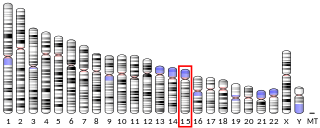Related Research Articles
Cholecystokinin receptors or CCK receptors are a group of G-protein coupled receptors which bind the peptide hormones cholecystokinin (CCK) and gastrin. There are two different subtypes CCKA and CCKB which are ~50% homologous: Various cholecystokinin antagonists have been developed and are used in research, although the only drug of this class that has been widely marketed to date is the anti-ulcer drug proglumide.
There are two known parathyroid hormone receptors in mammals termed PTH1R and PTH2R. These receptors bind parathyroid hormone and are members of the GPCR family of transmembrane proteins.
There are two known receptors for the vasoactive intestinal peptide (VIP) termed VPAC1 and VPAC2. These receptors bind both VIP and pituitary adenylate cyclase-activating polypeptide (PACAP) to some degree. Both receptors are members of the 7 transmembrane G protein-coupled receptor family.
There are three known mammalian tachykinin receptors termed NK1, NK2 and NK3. All are members of the 7 transmembrane G-protein coupled receptor family and induce the activation of phospholipase C, producing inositol triphosphate (so called Gq-coupled).
Neurotensin receptors are transmembrane receptors that bind the neurotransmitter neurotensin. Two of the receptors encoded by the NTSR1 and NTSR2 genes contain seven transmembrane helices and are G protein coupled. Numerous crystal structures have been reported for the neurotensin receptor 1 (NTS1). The third receptor has a single transmembrane domain and is encoded by the SORT1 gene.
Two Melanin-concentrating hormone receptors (MCHR) have recently been characterized: MCH-R1 and MCH-R2. These two receptors share approximately 38% homology.

Growth hormone secretagogue receptor(GHS-R), also known as ghrelin receptor, is a G protein-coupled receptor that binds growth hormone secretagogues (GHSs), such as ghrelin, the "hunger hormone". The role of GHS-R is thought to be in regulating energy homeostasis and body weight. In the brain, they are most highly expressed in the hypothalamus, specifically the ventromedial nucleus and arcuate nucleus. GSH-Rs are also expressed in other areas of the brain, including the ventral tegmental area, hippocampus, and substantia nigra. Outside the central nervous system, too, GSH-Rs are also found in the liver, in skeletal muscle, and even in the heart.

The Gs alpha subunit is a subunit of the heterotrimeric G protein Gs that stimulates the cAMP-dependent pathway by activating adenylyl cyclase. Gsα is a GTPase that functions as a cellular signaling protein. Gsα is the founding member of one of the four families of heterotrimeric G proteins, defined by the alpha subunits they contain: the Gαs family, Gαi/Gαo family, Gαq family, and Gα12/Gα13 family. The Gs-family has only two members: the other member is Golf, named for its predominant expression in the olfactory system. In humans, Gsα is encoded by the GNAS complex locus, while Golfα is encoded by the GNAL gene.
The EGF module-containing Mucin-like hormone Receptors (EMRs) are closely related subgroup of G protein-coupled receptors (GPCRs). These receptors have a unique hybrid structure in which an extracellular epidermal growth factor (EGF)-like domain is fused to a GPCR domain through a mucin-like stalk. There are four variants of EMR labeled 1–4, each encoded by a separate gene. These receptors are predominantly expressed in cells of the immune system and bind ligands such as CD55.
The prokineticin receptor is a G protein-coupled receptor which binds the peptide hormone prokineticin. There are two variants each encoded by a different gene. These receptors mediate gastrointestinal smooth muscle contraction and angiogenesis.
The Retinoic Acid-Inducible orphan G-protein-coupled receptors (RAIG) are a group of four closely related G protein-coupled receptors whose expression is induced by retinoic acid.
The MAS1 oncogene is a G protein-coupled receptor which binds the angiotensin II metabolite angiotensin (1-7). The MAS1 receptor, when activated by binding angiotensin-(1-7), opposes many of the effects of the angiotensin II receptor. Hence, MAS1 receptor agonists have similar therapeutic effects to angiotensin II receptor antagonists, including lowering of blood pressure.

Sphingosine-1-phosphate receptor 3 also known as S1PR3 is a human gene which encodes a G protein-coupled receptor which binds the lipid signaling molecule sphingosine 1-phosphate (S1P). Hence this receptor is also known as S1P3.

Probable G-protein coupled receptor 27 is a protein that in humans is encoded by the GPR27 gene.

Probable G-protein coupled receptor 173 is a protein that in humans is encoded by the GPR173 gene.

Probable G-protein coupled receptor 85 is a protein that in humans is encoded by the GPR85 gene.

Olfactory receptor 2M3 is a protein that in humans is encoded by the OR2M3 gene.

Olfactory receptor 2W3 is a protein that in humans is encoded by the OR2W3 gene.

Olfactory receptor 4M2 is a protein that in humans is encoded by the OR4M2 gene.
The leukotriene (LT) receptors are G protein-coupled receptors that bind and are activated by the leukotrienes. They include the following proteins:
References
- ↑ Matsumoto M, Saito T, Takasaki J, Kamohara M, Sugimoto T, Kobayashi M, Tadokoro M, Matsumoto S, Ohishi T, Furuichi K (2000). "An evolutionarily conserved G-protein coupled receptor family, SREB, expressed in the central nervous system". Biochem. Biophys. Res. Commun. 272 (2): 576–82. doi:10.1006/bbrc.2000.2829. PMID 10833454.
- ↑ National Center for Biotechnology Information, Conserved Protein Domain Family 7tmA_SREB1_GPR27, accessed 5 February 2022